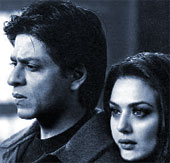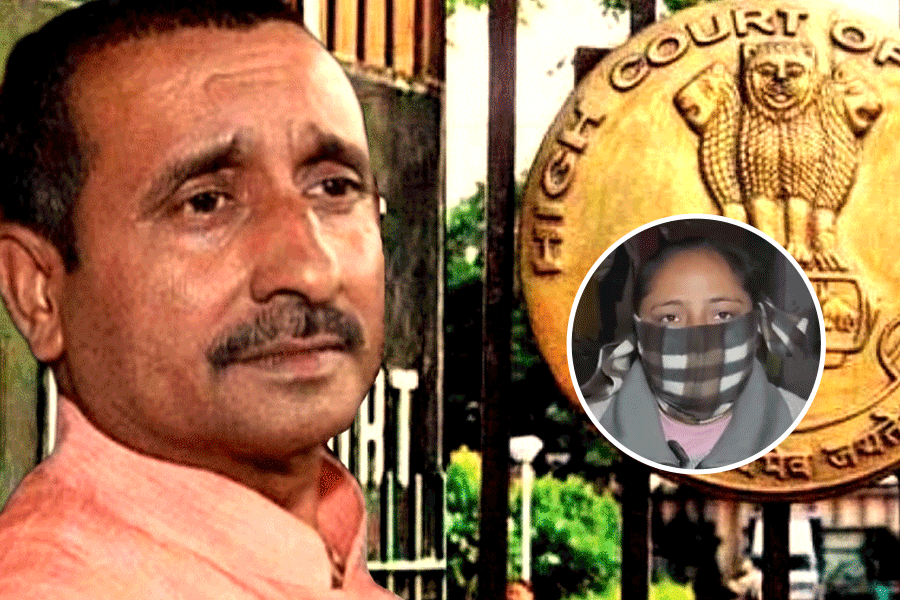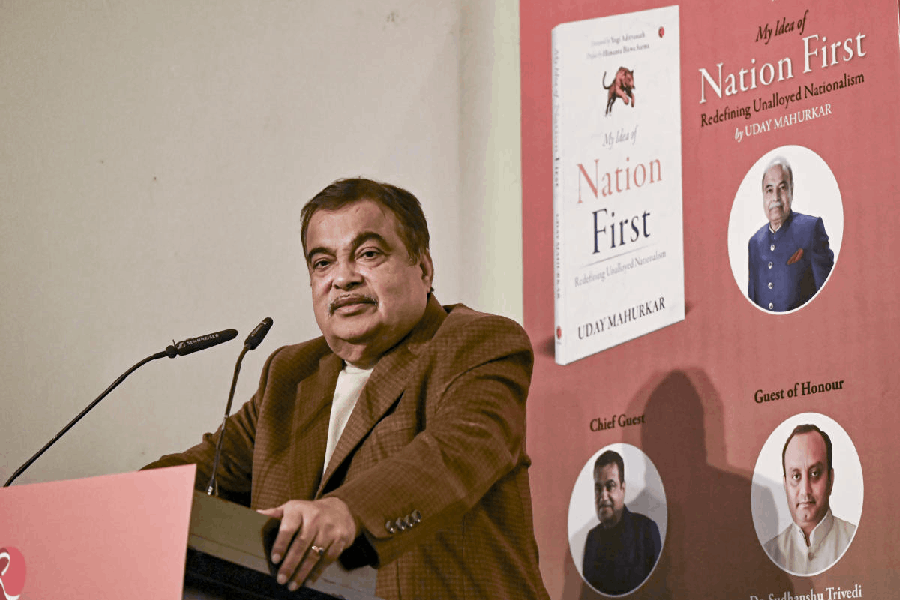 |
In an episode of Kasamh Se, a Balaji series telecast on Zee TV, Jay Walia and Bani play a game of dumb charades. Jay, looking suitably melancholic, clings to his Billo mausi. His team guesses the answer in a jiffy. Kabhi Alvida Naa Kehna, they belt out triumphantly. A couple in the foreground announces that it is a first-day, first-show must-see.
An MSN Messenger online contest calls for a 12-word answer on how the film succeeds in breaking stereotypes. Up for grabs are 150 film tickets, 100 music CDs and 50 posters.
That isn’t all: the song Mitwa — touted as director Karan Johar’s favourite number — has already become a caller tune and is set to top the music charts. With the film set to release this Friday, the hype is understandable.
Like it or hate it, you can’t ignore it. Kabhi Alvida Naa Kehna (KANK) is everywhere. Promos on television, radio and the Internet have ensured that it is the talk of the town.
The KANK case exemplifies how Hindi film promotion is being redefined like never before. “Today visibility is all important,” declares veteran film producer Manmohan Shetty. “It is important to communicate with the viewer on a one-to-one basis so that they feel compelled to watch the movie in the first week itself.” In fact, according to insiders, KANK has generated some Rs 15 croreworth of publicity before its release. Marketing, clearly, has become an integral component of new age Bollywood films.
Sceptical? Look at two more examples of how films are being promoted today.
Boman Irani’s photograph will soon figure on the real estate pages of national dailies. And the caption will read, “Beware of this man.” The teaser is meant to caution you against a real estate shark — played by Boman Irani in Khosla Ka Ghosla, a UTV production — who is out to grab any lucrative deal that comes his way. As part of a promotional gimmick, UTV also plans to gift a house to the winner of a contest to be advertised soon.
What is more, it’s been six weeks since the blockbuster Krrish was released. But Krrish is making its presence felt even now, especially among children. Last week, a new advertisement featured a little boy asking his friend: “Ai Chhotu, Krrish banega?” For five wrappers of Lifebuoy soap, you get a Krrish mask free and a chance to meet the superhero.
Promotion was never Bollywood’s forte. Posters, a few tacky hoardings, print advertisements and, at best, a press conference were all it took to announce a film. Promotional budgets were virtually non-existent.
Yash Raj Films, for instance, did not even have a marketing team till 2002, when Tarun Tripathi joined the Mumbai-based production house as its marketing in-charge. That’s changed today. A film’s marketing budget is now 40-50 per cent of the film’s total budget. The marketing budget for Madhur Bhandarkar’s Corporate nearly equalled the approximately Rs 5 crore cost of the film’s production.
Explains Tripathy: “Today content consumption is the focal area as the spurt of activities making inroads into people’s leisure space has gone up. That is why there is a need for brand visibility and hence marketing a film has become imperative.”
Filmmaker Rakesh Roshan agrees. The Krrish mastermind — whose film Koyla starring Shah Rukh Khan and Madhuri Dixit had been the ultimate disaster — waited for six months before releasing his Rs 50-crore film. “It was in the course of shooting for Koi…Mil Gaya that I learnt how important it is to tie up with different brands to maximise returns,” he says candidly. The right strategy, he stresses, is as important as creating an awareness and hype about the film on which it can ride for at least the first few weeks. “But next time, I will buy more time. Six months isn’t enough for promoting a film.”
Krrish masks and tattoos were available in the market before the film was released, thanks to an arrangement with retail chain Pantaloons. Similarly, the drink Café Kool Laté had hit 150 Barista outlets before the Tusshar Kapoor starrer Kya Kool Hain Hum was released last year. “A high premium is placed on marketing a film,” says Shenaz Nadirshah, head of films department, production and marketing, Balaji Telefilms.
Songs too are an essential marketing tool. With at least six music channels dedicated solely to songs, songs have become, as filmmaker Sanjay Leela Bhansali puts it, “the first fragrance of the film,” which lures first-weekend audiences. No wonder, then, that songs, especially item numbers such as the Kajre Re number in Bunty Aur Bubli, often divorced from the central narrative, are a huge draw.
Movies are now marketed in several other ways too. One way is to hawk the marketing rights to someone else. KANK’s marketing rights have been sold to Percept group’s P9 Integrated Pvt Ltd, which also bought the exclusive marketing rights of the blockbuster Krrish before the movie was released. “Just like cricketing rights are purchased, we bought the rights of these films. That way the producer is assured of returns from the sales of the film rights,” says Navin Shah, CEO of P9 Integrated, adding that the company then ties up with brands.
Brands such as Lifebuoy, Wills Lifestyle, Acron Rangeela (a Pidilite product) and Hindustan Petroleum Corporation’s Power petrol entered into a strategic tie-up with Krrish to derive mileage from the film.
KANK, however, “is a pre-sold film and has its own brand value,” explains Shah. That’s because the Karan Johar film has an impressive star cast and people have high expectations of it. “So it’s the high premium, lifestyle oriented, aspirational brands that want to be associated with the film, join the promotional fray and ride on the film’s hype. And it is they who pay a licencing fee to the producer,” Shah adds.
Indeed, brands and sponsorship deals are key factors in today’s movies. In KANK, Louis Vuitton and Nike are the brands that the stars flaunt while in Bhandarkar’s Corporate, the characters sport Allen Solly shirts and trousers. They use Lenovo’s laptops to seal deals — mostly underhand, though — and lounge on Durian furniture. These in-film product placements reduced production costs while cross promotions (such as the advertisement of Lenovo which uses the film’s clipping showing Bipasha Basu at a board meeting) helped promote the laptop as much as the film. “If the brand and the product are seamlessly woven into the film, there is no reason why it should take away from the film aesthetically,” says Bhandarkar.
Association with a brand also helps the movie’s producer to cut costs. The producer forks out only 10 per cent of the film’s budget for marketing; the rest comes from brand deals. “Usually the producer keeps aside a marketing budget of Rs 1.5 crore to Rs 2 crore. The remaining Rs 6 crore to Rs 8 crore is generated from sponsorship deals and brands which come on board,” points out Siddharth Roy Kapur, senior vice-president, marketing and communications, at UTV.
In some ways, it was Subhash Ghai who set a precedent by making Aishwarya Rai and Akshaye Khanna share a bottle of Coke in a song sequence in his film Taal released in 1999. That was what is today known as an in-film product placement. “It is a sound marketing and production model. Besides, in real life we are surrounded by brands so in that sense it is realistic,” elaborates Ghai. But he overused it to such an extent in his film Yaadein, starring Hrithik Roshan and Kareena Kapoor, that the film, released in 2001, is better known as a three-hour long advertisement for Coke, mouth freshener Pass-Pass and the Hero cycle.
Striking a balance, therefore, is essential. That’s what the film Waqt: A Race Against Time did. It subtly used the soft toy Geri Giraffe, an Archie’s product, to good effect. “Without drawing undue attention, it was perpetually embedded in the film and was thus available in any format and screened anywhere in the world,” says Rupali Mehra, director, marketing and corporate alliances, at Ad. Vista Bombay Private Limited.
Merchandising products — Devdas notebooks featuring Aishwarya Rai, Fanaa cups, Hanuman dolls, Krrish rings along with a prêt line — such as that inspired by Devdas — and a jewellery line on the lines of the jewellery used in Paheli — have added to non-traditional revenue streams. For each product sold, the movie producer gets a royalty. In fact, at the moment Rs 6 crore worth of Krrish goods — masks, tattoos, rings etc — are in the market. Ring tones, caller tunes, wall papers, downloadable video clippings and home videos are not just profitable sidelines but also go into the hype-building process.
Such seismic changes in film production and promotion have led to a situation where box office revenue is no longer as crucial as it used to be. The Aamir Khan starrer Mangal Pandey: The Rising, for example, bombed at the box office. But the marketing expenditure of about Rs 40 crore paid off. A microsite on the film, an Aamir Khan blog on MSN, a Mangal Pandey look-alike contest and the sale of mobile rights to the Bharti group (Airtel) went into promoting the film. The film, released with 1,000 prints, had 60 shows on the first weekend and collected 64 per cent of the money it spent in the opening weekend itself.
That’s the modus operandi followed for most Hindi films today. Films use promotional gimmicks to create a hype and then release 700-800 prints nationally, at a cost of Rs 50,000 per print. These are distributed to as many territories as possible in the first two weeks before piracy, bad press or other media clutter get to the film. “A good opening can help cover the cost of production. Cent per cent collections on the first three days can often ensure that the cost is recovered,” notes distributor Shyam Shroff.
So risks have plummeted and the success rate of films has gone up with additional sources of revenue adding to the bulge in the producer’s kitty. “This augurs well for the Hindi film industry,” emphasises Taran Adarsh, editor, Trade Guide, a film trade publication. Actors Hema Malini and Kirron Kher vouch for that. “Today there is a method to the madness,” says Kher. “The chaos of the past has made way for order. Everything is far more organised and structured,” adds Hema Malini. Clearly, all’s well that begins well.
QUOTE UNQUOTE
Songs have become the first fragrance of the film.
Sanjay Leela Bhansali
It was in the course of shooting for Koi... Mil Gaya that I learnt how important it is to tie up with different brands to maximise returns.
Rakesh Roshan
In-film product placement is a sound marketing and production model.
Subhash Ghai
The chaos of the past has made way for order. Everything is far more organised.
Hema Malini










